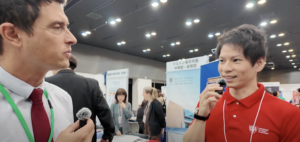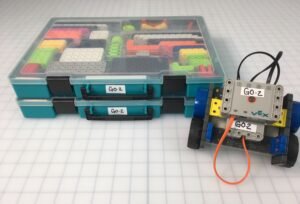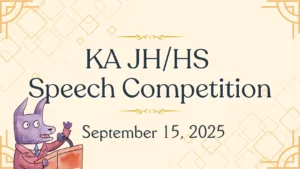Experience the highlights from the “International Education Fair – IEExpo Osaka 2024 Autumn”! This video captures the essence of international education through interviews with school leaders, insights into global educational trends, and opportunities for students worldwide. A must-watch for anyone passionate about the future of education, this video showcases how educational institutions are preparing students for a globalized world. Enjoy exploring the innovative approaches to learning and the unique community atmospheres of various international schools.
Transcript
Please note: Clicking on the timestamp will take you to the start of their clip in the video. Clicking on the school name will take you to their website.
00:12-00:49 – Nexus International School Singapore
Nexus International School Singapore: (00:18) Yeah, so it’s, it’s a great school situated very centrally in Singapore. At the moment, we’ve got 1,527 learners and they are pretty much evenly spread between primary and secondary. We have a very vibrant community of over 60 different nationalities. And, for whatever reason, we don’t have any one nationality more than 15%. So it’s a very diverse community. Um, the nationality with the most kids are at the moment the British with about 14%. Um, but in every class you have in either primary or in secondary, you will have about 10 to 12 different nationalities in a in in a class. So it’s a very, very diverse population.
00:51-02:29 – Brighton College Singapore
Brighton College Singapore: (01:07) And so in our uh drive to launch this program, um, we were very fortunate to see a a pretty sizable uptick in uh in Japanese families seeking this type of uh format for their children to attend school. And uh so we’re we’re about 25%, between 25, 30% of our pupils currently in the PCP program, preparatory course for primary, um are are are Japanese nationals. And in speaking with uh those families, the the moms and dads, um, many of them highlight the fact that our unique structure is a really big selling point for them. It’s small classroom sizes. It is a a tripod of teacher approach where three teachers uh working together create a uh a really robust lattice work of support for their for each of our people’s wellbeing. Um, we have a very rigorous academic program that honors their uh their native language. So we we we really try to use a translanguaging approach. Um, we use a lot of bilingual approaches in order for um our pupils no matter where they’re coming from, whether it’s uh uh Japan, uh China or or Russia, they get to use their mother tongue as they’re developing their uh their English language proficiency on their way to uh going into the mainstream.
02:30-03:44 – Osaka Kongo International School
Osaka Kongo International School: (02:35) So in collaboration with the Korean government, the Japanese government came together and they built this school. Uh, and since it opened, it’s kind of evolved uh into an international school and it welcomes people from all sorts of backgrounds and um our student body is pretty diverse in that sense. Um, but because we set up originally as a Korean school, uh, we do a lot of education with Korean language, history and um, it actually, it allows students to pursue a career in Korea and other international uh fields. So it’s, it’s quite a unique unique school in Osaka and then in Japan, in fact. Yeah.
03:45-04:33 – Harrow International School APPI – Japan
Harrow International School APPI – Japan: (03:49) We we always explain to parents, it is actually like a Harry Potter because once you enter school, you’ll you’ll be assigned to A house, which is actually it’s a vertical system. So you’ll be living with older kids or younger kids together, of course within same gender. Um, but then the the rooms will be assigned based on their ages. So younger kids, they’ll be living with um three students in a room. And the junior students, they’ll be living with two students in a room. And then when they get older going into sick form, they’ll have a privilege to have their own room. Then of course that comes with responsibilities too. So really older students looking after younger kids, younger kids, you know, look looking up, um, you know, trying to catch up with older kids. So it is really like a like a small family.
04:34-05:23 – Osaka Gakugei Canadian International School
Osaka Gakugei Canadian International School: (04:38) So, we are international school within our whole school. So our whole school is Osaka Gakugei Senior High School. Um, and I think in total we have about 1800 students in the whole school. Um, we’re just one part of it and we currently have about 50-ish students. Um, so we’re a small school within the whole school, but extracurricular activities we do as a whole entire school. So we do have like strong karate clubs that just won, you know, world championships. Um, and uh soccer teams that play for professional women’s soccer league as well. And uh volleyball, basketball, all all kinds of sports. Breast band is also strong. And our students that go to this international school are also free to join those activities with the whole school.
05:24-06:35 – Stamford American International School
Stamford American International School: (05:28) I will tell you, we have two campuses. Our first campuses is the early learning village where we have a swimming pool. We have the classroom who are always shared indoor and outdoor. We have six playground that are covered and thematics with for example playground around music, one around physics elements. So gravity for example. And at our Woodley campuses, we have three swimming pool. We have one rock climbing wall. We have also a golf simulator academy.
06:36-07:59 – Riseisha Junior and Senior High School
Riseisha Junior and Senior High School: (06:40) So, Riseisha is a um Japanese private school based in Osaka, Northern Osaka in Toyonaka City and over 100 years history. And uh we have lots of international programs uh that supplement the core program, which is a Japanese curriculum by the Monbusho, the Ministry of Education of Japan. So I’m one of the teachers there. I’m a native English speaker from uh America. Um but we have other teachers, uh very good English teachers that teach English in English. And uh we have, as you mentioned, international programs. For example, we have an optional program for students to um take courses in English with a high school in US. And that is called a dual diploma program, which is described in our brochure. ISTimes Global: (07:33) So it’s a uh so it’s a supplementary program with that if they take that, they would of course get their Japanese diploma recognized by the Japanese government. But then with this supplementary program, they would also be getting a US diploma. Riseisha Junior and Senior High School: (07:47) That’s right. And that gives them more options for the future. So they get a regular Japanese high school diploma plus a US high school diploma, which enables them to enter, of course, universities in the United States and elsewhere.
08:00-09:36 – YMCA
YMCA: (08:05) in our program, we have the uh many students really want to go to Denmark because we have the yeah, our school trip is Denmark. And ISTimes Global: (08:15) Oh so so you have a sister school there? YMCA: (08:17) Yeah, kind of. not YMCA, but our graduate is working in Denmark. and it’s EIS Iceberg uh efterskole. Efterskole is like a school, but not high school. After they graduate secondary school, they have one year program that they can just think about their futures. And uh we have a relations. So two weeks uh in December, our second graders go to Denmark. And uh after they came back to Japan, we have two weeks uh Denmark students are coming. And ISTimes Global: (08:52) Also Yeah, yeah yeah, Danish are coming. So YMCA: (08:54) Danish are coming. So ISTimes Global: (08:56) So there is a cultural uh exchange with uh other countries. YMCA: (08:58) exchange. Yes, yes. ISTimes Global: (09:01) other countries. And is is that something that you see parents uh really look forward to when coming to school? YMCA: (09:05) Yes, yes, look forward to. Yes. Yes, not only parents, the students really want to go to Denmark and uh it’s not only just exchange, but also uh every year we have the theme. So the last year the life with AI was the theme. So uh the we would like the students not only just communicate, but also think about their future together. Uh what can they do for better future. So all together.
09:37-11:05 – Abroad International School
Abroad International School: (09:41) cultural school. One thing I should say, uh we are family like atmosphere. I mean, we have that family like, which which I really like. Actually, like uh past uh week, we had our PYP evaluation visit. The visitors, they told us, wow, this is just like a family. They met families, students, everyone, you know, everyone happy. The the older grades have activities with younger ones. So this is just like a family. So this is your home, they told us. So we were so happy with that feedback, you know. ISTimes Global: (10:16) Can I ask so if if if you were to ask parents or students, what would be the first thing that they would come to mind when they think about the school? Would it be the fact that it’s a family atmosphere? Abroad International School: (10:25) I think that would be the thing. right? This is like this is our family. This is our family. They like the the older grades, they see like their older, you know, brothers and sisters. since they meet at the campus, it’s from one year up to currently by the way, we have grade nines. So each year we gain one grade. So next academic year we’ll have our grade 10, 11 and 12. So the upper grades, they have lots of chances to meet their younger, you know, we have a school assembly every once in a while, so we have all together. So they’re all together, you know, having these assembly. The the older ones, they they manage the assembly actually, the students led assemblies.
11:06-13:22 – ASCOT International School
ASCOT International School: (11:10) Our school’s mainly meant for science and math. That’s our big push. But we also do a lot of SDG, uh, yeah, SDGs in our school. We do recycling of coffee. We grow a lot of things in our farm using recycled coffee into our composting. And we also have a seven acre uh forest where we take students and they learn about the forest area because we have a nature school for kids three years old all the way through high school. ISTimes Global: (11:35) Do do kids uh commute to to your school or is it a uh or do they ASCOT International School: (11:39) So we have about 40% of our students drive to our school from from home. And then the rest come from all around because we have buses that go to Kobe, Takarazuka and Sanda. ISTimes Global: (11:50) Okay, that’s great. And uh how would you describe the school um school culture? It seems like you’re very surrounded by nature and fields. ASCOT International School: (11:58) Yeah, we try to be a family school. Everybody cares about each other. We want to do things to help each other. We have a lot of students that have come from other schools that have really they they need somewhere where they’re actually thought of as as great people. We really try to push our students to a higher level, make them understand that uh that all students are are special and that they all have greatness inside of them and can be really good in the end if they really wanted to. We also don’t push college, we push jobs. Where do you want to go for your profession? Does is college part of that? Then we need to get you into a good college, we need to go there. If not, then we go right into the profession. So we have some students that are making uh their own cafe at our school, making different goods. Uh we have a student run area that they’re trying to make a farmer’s market and invite all the outside area people that that do, you know, building of uh like hand goods, sewing and things like that, so that they can have a place to sell. So we’re trying to do a lot for our community too. From a young age, we have experiments every week for every student from age six on. And so we we don’t just teach science, we have them do science. And that’s also with our nature school. They go out and they do science with that. And then the mathematics comes with that also because they do measurements, they learn about physics very young to see if like how would a tree fall, what kind of uh carbon would be inside a tree, things like that that connect to our SDGs.
13:23-15:12 – Rugby School Japan
Rugby School Japan: (13:28) So, I mean, I think the legacy of rugby school is important to us, but in terms of it it rugby school really invented character education and also boarding and and came up with the first boarding houses. So we’ve got that legacy to protect and nurture and that that character education and and what happened was that William Webb Ellis caught the ball 201 years ago, invented the game of rugby, but he was really brave to do that. And we want brave children. We want to really empower them to take brave decisions, to really enjoy different experiences here in Japan. And so those two things really really are what what binds the community together. At the moment we’ve got just under 230 pupils and we intend to grow to a maximum of around 760. So we’ve got some growth to do. We’re being quite selective with the pupils that we take on and the families because they need to understand our ethos. I think in terms of our uniqueness, one of the things that we’re doing is developing really unique, strong partnerships. So next door to us is the University of Tokyo and also University of Chiba and and we form partnerships with both universities. So University of Tokyo professors are coming in next week for instance to to look at our teaching and pedagogy and our pupils will go and visit their their PhD campus. So that’s an example of a partnership. Last week we um took a group of girls to Google and they met the worldwide chief exec of Google. It was fantastic. And again this Yeah, I know. It’s fantastic experience. And that program was all about trying to get girls into tech and really pushing that. And again, a real unique partnership with outstanding world leading organizations. That’s what we’re about.
15:13-16:09 – Canadian Academy
Canadian Academy: (15:17) It’s it sounds like you’ve built a very long trusted community over a long time. And I think the fact that they’re that they would come back after so long, it seems like they’ve they’ve they’ve been left with something that’s carried throughout their whole life. ISTimes Global: (15:34) And we’re really lucky they always say, you know, that you know, many have been here for 10 years, but some have only been here for two years, right? So we call them alumni, but not all of them have graduated our school. But yet, you know, they keep on coming back for visits and they say this has been the profound time period of my time, you know, of my my student life. And that’s why they keep on coming back and they also want to like meet their old teachers, they want to visit their old classrooms, uh walk down memory lane and so that’s always been a pleasure because I’m also in fact in charge of alumni relations. So uh my take care of those as well.
16:10-18:12 – North London Collegiate School Kobe
North London Collegiate School Kobe: (16:14) We are very, very grounded and connected to our school in the UK. It is our mother school. We have a partnership of sister schools and we have the same educational ethos, academic excellence, but we believe that is only possible because of our commitment to pastoral care, the wellbeing and development of individual children. And of course, the development of extracurricular activities goes along with that. We want our kids to be dynamic in the classroom, but also beyond the classroom. What makes us exceptional here in Kobe, there are many wonderful schools that offer IB and internationalism, but we really want our curriculum to be exceptional. The learning experience will be exceptional. It will be international in its outlook, very, very challenging and delivered in a North London collegiate school way that always means excelling and exciting. But we want our curriculum to also have Japanese elements in which we embrace Japanese values, culture, tradition, language. And we want our curriculum to be very accessible to Japanese children so they see its relevance. We want Japanese children to be world ready and recognize the fantastic skills and experience and heritage that they have to bring them forward onto a global stage. We’re also super excited about our Rocco Mountain development that will open in 2028. Construction and planning is underway and we know that that that site will be absolutely unique in having the most fantastic facilities. We’ll have outside experiential learning, a curriculum that’s linked to sustainability. And our children will be having the most intellectual challenge, but in an environment that promotes wellbeing and their health because we’ll be in nature. So we are we are going to be absolutely unique and I am so excited.
18:13-19:26 – Kikokushijo Academy
Kikokushijo Academy: (18:17) Well, I think KA is really different from other cram schools because we are an all English school environment. Uh we don’t speak any Japanese with our students. Once they come to KA, it is an all English environment. And a lot of um our students kind of miss that from the countries that they live overseas. So in a way it’s kind of like a second home for them. They’re able to be themselves, they’re able to speak English again, uh which they might not be able to get if they’re going to a Japanese school. Of course, we’re international school students that’s a little bit different, but a lot of our students also just go to Japanese school and they come to KA for two hours a week. Um of course, it’s it’s not uh great to just uh learn English for two hours a week. So we also offer a lot of online programs where students can join English classes throughout the week. Uh it’s a program called KA Plus and from 4:00 to 8:30, uh we have live classes for students to join. So I think a typical student would come to KA uh on campus or online for the two hours of their core class, and then they take English classes um throughout the week. Uh the English classes can include art classes, science classes. Um and so I think that’s what a typical KA student would experience.
19:27-20:33 – St. Michael’s International School
St. Michael’s International School: (19:32) We are a small school with a big heart. Our school is built on Christian values and we welcome children from all faiths and none. We have around 200 students from over 30 different nationalities. Our small size means we can really get to know each child as an individual. We follow the English National Curriculum but with an international perspective. Our students go on to some of the best schools in Japan and around the world. What makes us special is our focus on developing the whole child – academically, socially, emotionally and spiritually.
20:34-21:55 – NUCB International College
NUCB International College: (20:39) We are Japan’s first international boarding school offering the International Baccalaureate Diploma Programme. Our campus is located in the beautiful countryside of Aichi prefecture. We have students from over 20 countries living and learning together in our residential community. Our unique curriculum combines rigorous academics with leadership development and outdoor education. Students graduate with both the IB Diploma and a Japanese high school diploma, giving them access to universities worldwide. Our small class sizes and dedicated faculty ensure each student receives personalized attention.
21:56-23:01 – XCL World Academy
XCL World Academy: (22:01) We are an IB continuum school offering all three IB programmes from Primary Years through to Diploma. Our diverse community represents over 60 nationalities. We pride ourselves on our personalized approach to learning – each student has a customized learning plan. Our state-of-the-art campus features world-class facilities including a 500-seat theater, Olympic-sized pool, and makerspaces. Our graduates attend top universities worldwide. What sets us apart is our focus on real-world learning through partnerships with businesses and organizations in Singapore and beyond.
23:02-24:57 – KiS International School Reignwood Park
KiS International School Reignwood Park: (23:07) We are a leading IB World School located in Bangkok, Thailand. Our beautiful 50-acre campus features state-of-the-art facilities including a performing arts center, sports complex, and STEM labs. We offer all three IB programmes to students from over 50 nationalities. Our holistic approach focuses on developing inquiring, knowledgeable and caring young people who help to create a better world through intercultural understanding and respect. Our graduates attend top universities worldwide and we pride ourselves on our strong alumni network.
24:58-26:50 – EPSOM College in Malaysia
EPSOM College in Malaysia: (25:03) We are a British international boarding school offering the English National Curriculum and A-Levels. Our 50-acre campus in Bandar Enstek features world-class facilities including an Olympic-sized pool, performing arts center, and extensive sports fields. We have students from over 30 countries with a strong boarding community. Our academic results consistently rank among the top in Malaysia. What makes us unique is our combination of British tradition with an international outlook, preparing students for global universities and careers. Our pastoral care system ensures each student is supported academically and personally.
26:51-28:39 – One World International School
One World International School: (26:56) We are a values-driven international school with campuses in Singapore. Our diverse community represents over 70 nationalities. We offer the IB PYP and Cambridge IGCSE curricula with an inquiry-based approach to learning. Our small class sizes ensure personalized attention for each student. What makes us special is our focus on global citizenship and sustainability. Our students participate in service learning projects locally and internationally. Our campuses feature modern learning spaces, sports facilities, and technology integration throughout. We prepare students to be compassionate, lifelong learners who can thrive in an interconnected world.








